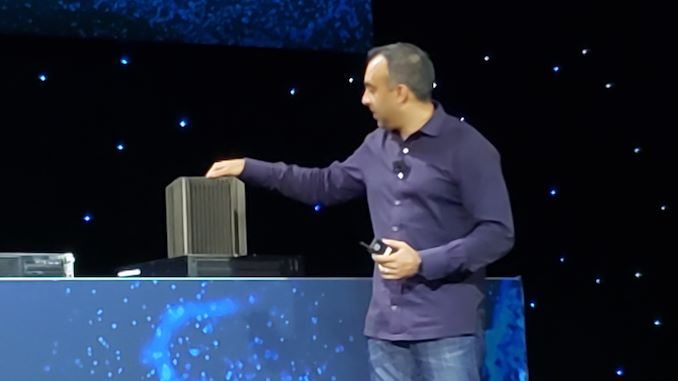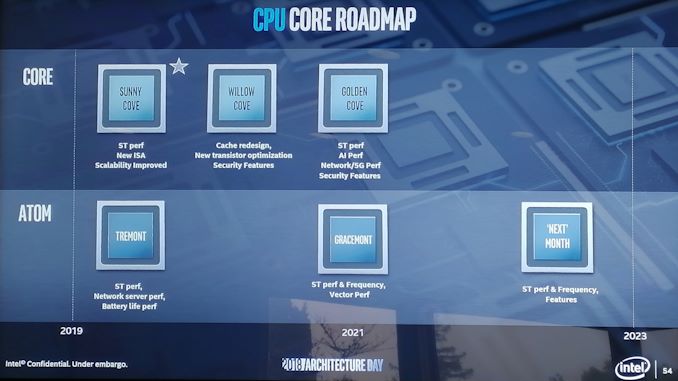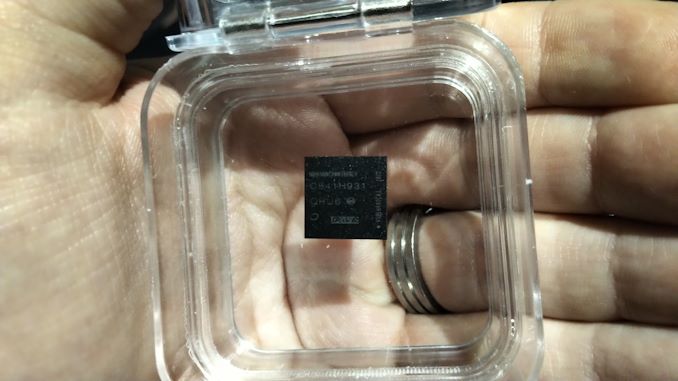Next Generation Intel Atom Tremont: Potential L3 Cache
by Dr. Ian Cutress on July 15, 2019 8:00 AM EST
Intel has already disclosed that it will have a next generation Atom core, code named Tremont, which is to appear in products such as the Foveros-based hybrid Lakefield, as well as Snow Ridge designed for 5G deployments. In advance of the launch of the core and the product, it is customary for some documentation and tools to be updated to prepare for it; in this case, one of those updates has disclosed that the Tremont core would contain an L3 cache – a first for one of Intel’s Atom designs.
01.org is an Intel website which hosts all of its open source projects. One of those projects is perfmon, a simple performance monitoring tool that can be used by developers to direct where code may be bottlenecked by either throughput, memory latency, memory bandwidth, TLBs, port allocation, or cache hits/misses. In this case, the profiles for Snow Ridge have been uploaded to the platform, and one of the counters provided includes provisions for L3 cache monitoring. This provision is directly listed under the Tremont heading.
Enabling an L3 cache on Atom does two potential things to Intel’s design: it adds power, but also adds performance. By having an L3, it means that data in the L3 is quicker to access than it would be in memory, however there is an idle power hit by having L3 present. Intel can mitigate this by enabling parts of the L3 to be powered on as needed, but there is always a tradeoff. There can also be a hit to die area, so it will be interesting to see how Intel has changed the microarchitecture of it’s Atom design. There is also no indication if the Tremont L3 cache is an inclusive cache, or a non-inclusive cache, or if it can be pre-fetched into, or if it is shared between cores or done on a per-core basis.
Intel’s Atom roadmap, as disclosed last year at Architecture day, shows that the company is planning several more generations of Atom core, although beyond Tremont we get Gracemont in 2021, and beyond that is ‘increased ST Perf, Frequency, Features’ listed around 2023. In that time, Intel expects to launch Sunny Cove, Willow Cove, and Golden Cove on the Core side.
The first public device with Tremont inside is expected to be the Core/Atom hybrid Lakefield processor, which uses Intel’s new Foveros stacking technology. We know that this design will have one Sunny Cove core and pair it with four Tremont cores. Intel expects chip production of Lakefield for consumer use by the end of the year.
Related Reading
- Intel's Architecture Day 2018: The Future of Core, Intel GPUs, 10nm, and Hybrid x86
- Intel Lists New Atom Core: Tremont to Come After Goldmont Plus
- Intel’s Keynote at CES 2019: 10nm, Ice Lake, Lakefield, Snow Ridge, Cascade Lake
- Intel's Interconnected Future: Combining Chiplets, EMIB, and Foveros
Source: InstLatX64, 01.org














66 Comments
View All Comments
mode_13h - Wednesday, July 17, 2019 - link
Persistent L3 cache would make it more efficient for a CPU to sleep and periodically wake up to do some small amount of work.However, for security reasons, I'm thinking persistence wouldn't be utilized across reboots, etc.
HStewart - Monday, July 15, 2019 - link
I very curious about the efforts that Intel is doing here, I believe there is more happening here because there is a major change it chip design here - it sounds to me that the Lakefield has a fast core for computer and 4 Tremont cores for backgound tasks - which sounds idea for portable always on computer.But this Snow Ridge is a server based product and I believe it more than just Xeon D. There might be reason for Xeon Phi discontinuation and Snow Ridge could be the reason. With larger cache and more cpus in device, this could be excellent low power server. I would not doubt 16 or more cores is likely in very small space.
Toms Hardware has interest article about Intel plans past Foveros and part it discusses CO-EMiB which is designed for datacenter - which sounds like it combine 4 Foveros together which each having 8 chiplets - to me that sound like at least 32 core system that is only if one core per chiplet which I would assume it could have more
Do me Snow Ridges sound like next generation of C3000's series.
HStewart - Monday, July 15, 2019 - link
Supremicro has C3xxx based system aim at cloud computinghttps://www.supermicro.com/en/products/system/3U/5...
IntelUser2000 - Wednesday, July 17, 2019 - link
Snow Ridge is specifically set to act as a compute node for 5G base stations. It's not C3000 successor which is general purpose.They'll likely have a Tremont-based successor to C3000.
abufrejoval - Monday, July 15, 2019 - link
So that's the reason you can score Gemini Lake Atoms or J5005 all of a sudden again?They used to be near impossible to obtain!
I got one last week; turned out very much more responsive than the J1900 and N3700 I already had, at least on Windows 10: Really nothing to complain about even on a 4K screen, can't say that an Nvidia 2080ti on an 5GHz i7 or a 4GHz Xeon 18 core is dramatically faster on Firefox or Office.
I had DDR4 SO-DIMMs lying around 1x 32GB and 2x 16GB that seemed sad to waste (and were priceless a year ago), so that's why I clicked on 'order' when a full Mini-ITX ASRock MoBo could be had for much less than the price of that RAM at the time (turns out, it's quite reasonable these days).
Actually, after the really impressive initial tests on Windows I got greedy and ordered another two, to create an oVirt Gluster for functional testing but at zero acoustics and very little power.
Alas, the on-board RealTek has issues with more complicated things on Linux, some of which can be healed by cold-booting (warm boots seem to loose the network on CentOS...)
It's also not generally as snappy on a Linux desktop as it is on Windows, but that's now how I plan on using them.
The common theme on all Atoms since the J1900 (Braswell, I think): Those 8GB RAM limitations are 'market segmentation lies', whatever RAM you can physically fit into those SO-DIMM slots, the Atoms will address it all. With DDR3 16GB were never any issue, with DDR4 32GB work just fine, too.
Few will actually feel tempted to load a $100 system with 32GB of RAM, but I thought it worth mentioning, that you could.
I only wish they'd make these boards with some higher quality 5Gbit NBase-T onboard NICs, too for say a $20 premium, because that would make them a nicely rounded fanless/noiseless low power home appliance.
Jorgp2 - Monday, July 15, 2019 - link
Isn't the J5005 NuC discontinued?abufrejoval - Tuesday, July 16, 2019 - link
Not using a NUC, because those have fans. These are ASRock Mini-ITX boards (€116 with VAT) in a chassis just big enough to house it with up to 2 SATA SSDs using a massive heat-sink.100% silent and typically 6-8 Watts at the wall plug on idle.
The chassis (€40 with VAT) comes with a 65 Watt 12V power brick and an internal 12V -> ATX power conversion unit that isn't optimal at that load point, but who knows what will be in there two years down the road? I prefer modularity.
There are silent conversion kits for NUCs, but those are only worth paying for on high-end variants with i7 or similar.
Some of those configurations (NUC7i7BNH, for example) would be rather nice to have as Mini-ITX, alas Intel won't have it!
I have an i7-7700T (35 Watt) running as pfSense appliance with a Noctua NH-L9i fan in a chassis like that and you have to put your ear right next to it to hear anything. Under constant high loads (deep inspection of 400MBit traffic) it becomes noticeable but never a bother. Normal loads and even shorter spikes (several seconds) get completely buffered inside the high mass of the Noctua cooler.
Whereas even with 15 Watt NUCs I found them far too noisy on high loads and far too nervous with the fans: Almost an audible CPU graph... yucks!
If NUCs had Noctuas, I might go for them, especially with Thunderbolt/USB4 replacing PCIe slots. So far they are design over function.
mode_13h - Wednesday, July 17, 2019 - link
In addition to the ASRock board, there's also the Odroid H2, which Gemini Lake-based and a similar price. Obviously, case selection is far more limited, but at least you can go smaller than mini-ITX.BTW, Intel makes certain NUC models for heavy-duty use (i.e. built for sustained high CPU load).
abufrejoval - Tuesday, July 23, 2019 - link
What's nice about the Odroid is an M.2 SSD slot: The ASRock only has SATA, but 4 ports via an ASMedia SATA controller. On the other hand, the entire SoC can't really handle anything much beyond 5-6Gbit anyway, so the major M.2 advantage may be size and the M.2 premiums at least have largely disappeared.It also maintains the 32GB RAM capacity, which is an incredible bonus, if you want to run a couple of low compute yet significant size (RAM+SSD) virtual appliances at lowest noise/energy. And RAM is so *cheap* these days: I wish they had 4x SO-DIMM Mini-ITX motherboards for 64GB of RAM at €300! (and with ECC)
Just having a 12V power supply is another huge benefit: The 12V to ATX conversion units take a lot of space and are most likely wasting electricity: The Odroid has it, I have not seen any affordable cheap Mini-ITX variants that have it, too.
Of course the Odroid has a lower bin SoC with fewer GPU EUs and 300MHz less clock at the same TDP: Perhaps not a killer criterion, but given a choice, I know where I tend to aim...
The two RealTek NICs may be a mixed blessing: I really want something that goes along with the 5Gbit theme here, either a 2.5 or 5Gbit NBase-T NIC to match what USB 3 does, too.
You can get 5Gbit Ether for USB 3.1 but these NICs easily double the price of the entire system: RealTek has a 2.5 Gbit chip (supposedly even a 5Gbit one) that won't cost an arm and a leg and are a match so much better to these silent SSD systems you can have a affordable prices these days.
Sure, let there be "tape" in the form of >10TB HDDs on an Atom server node, if you need that space. But please, only turn it on during backups, otherwise let's stick to 100% passive and no-noise, please!
What's still missing: ECC. But that costs an arm and a leg, except with AMD. Yet, they don't offer 15-45 Watt TDP APUs for the current Ryzens just yet (or at least not in retail).
Intel overcharges like crazy for C3000 Denvertons that support it and Xeon 2000 in the 35Watt TDP range are paper launches from what Google can find in terms of purchasable motherboards.
The market is segmenting in ways that enable few cross-over products or synnergies.
You either go down the performance road with normal DIMM sockets and CPU/APUs in the >65 Watt TDP range, or you have 15-35Watt TDP soldered-on BGA systems with SO-DIMMs that aren't available in PC form factors like Mini-ITX. NUC is the only mobile-technology/desktop-use-case product you can get and typically that means no control over fans and noise.
Expandability is all external via ThunderBolt/USB4 (good), but that market still has Mac prices.
I don't know if SO-DIMMs as a form factor are really a technical challenge vs. normal DIMMs (shorter traces should always be good in GigaHertz), but if they aren't I'd sure like them to be universally adopted, just because space is a premium, but shouldn't be in price.
mode_13h - Monday, July 15, 2019 - link
The real reason you couldn't get them was the supply-crunch in Intel's 14 nm fabs. As those were lower-margin parts, they went to the back of the queue.I think Intel's 14 nm supply issues have largely been alleviated, by now. Perhaps somewhat due to a dip in demand.